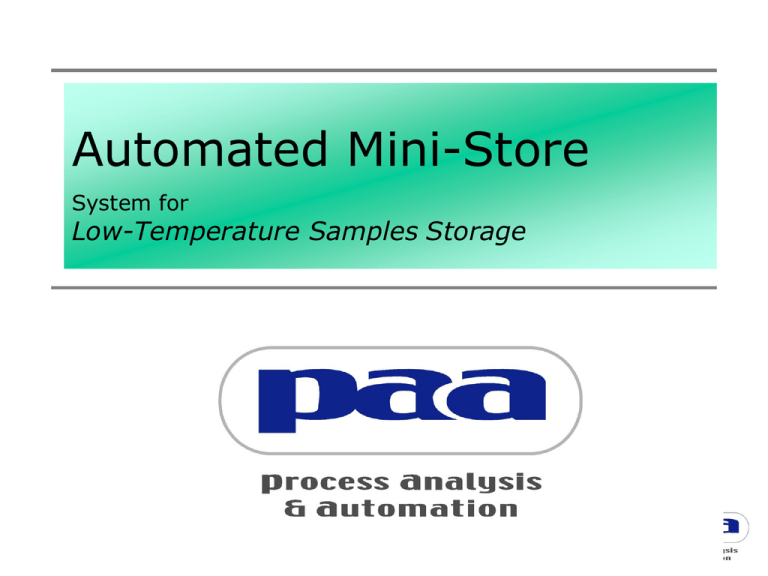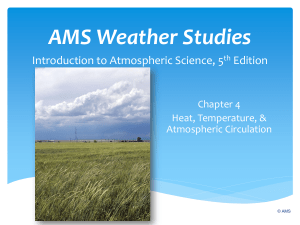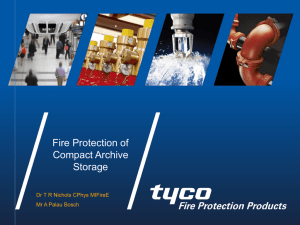Automated Mini-Store (AMS)
advertisement

Automated Mini-Store System for Low-Temperature Samples Storage Lab Automation solutions by PAA/Biosero Focused offerings for high-throughput screening applications Automated Samples Storage Systems • Range of capacities and functionalities • Ultra-low temperature robotic sample storage • Automation integration – Front/back-end Controlled-Environment Chambers Targeted for manual and automated work-processes Dry, inert, oxygen-free, ionized, temperature-controlled atmospheres possible Dry, nitrogen atmosphere for automated liquid-handling workcell Dry, nitrogen atmosphere for samples weighing Automated Mini-Store (AMS) For small-medium libraries General features • • • • • Standalone, self-contained, mobile Configurable for range of tubes and vials Cherry-picking capability Medium-capacity; expandable Modular design AMS Features and Specifications 1/2 • • • • • System Size: 8’ wide, 5’ deep, 6.5’ tall Capacity: 300,000 micro-tubes (0.7ml) Throughput: 4000 picks/day; higher possible Cherry-picking: Yes, for 96- and 384-well Operating environment: o +4ºC to -20 º C (settable) o -80 º C option available • Environment Backup: Liquid Nitrogen AMS Features and Specifications 2/2 • Input/Output Station: Positions for 6 racks • Output Stacker: 24 racks capacity • Compression/Consolidation: o On-demand or auto • Database: Any SQL database • Samples ID: 2D matrix and 1D barcode Container Types and Capacity 96-well Tubes, Standard-height (1.4 ml) 275,000 tubes (max 300,000) 96-well Tubes, Half-height (0.7 ml) 175,000 tubes (max 190,000) Picoplates (or Microtiter plates) 1.9 Million picotubes 2.6 Million in stacked configuration Other Container Types Vials, custom racks and tubes are possible Multi-Container Types in Single AMS AMS can easily be configured to simultaneously handle multiple container types in a single system. This is achieved by using gripper-changers at the Picking Robot for handling each container-type (similar to our larger ASRS) Note, however, that this affects the overall throughput of the system (and some loss of flexibility) Modules View – Main Discrete Modules Picking Module Storage Module #1 Storage Module #2 Input/Output Module Modules View – Storage Stack Storage Stack Single Pan Modules View – Picking Module Extractor Extractor transfers product from storage module to picking module Picker Picker (robot) cherry-picks samples from source-racks to destination racks Modules View – Pan in Extractor Picking Module – Picking Station Cherry-Picker Can pick tubes and vials of various sizes I/O Buffer I/O Buffer can hold 6 racks Pan Extracted for Picking Extractor Picker Source Rack I/O Module Modules View – I/O Module System display I/O Stacker Rack Scanner Dry Inert enclosure for plate thawing • Inert / dry plate exit hotel • Dry Nitrogen atmosphere • Room Temperature thawing • Recirculation with inline warming & desiccating module. • Intelligent control with O2 and humidity sensors to monitor environment • Minimal N2 consumption Sample Retrieval from the Inert hotel The available capacity of the Hotel allows for batch loading of tube racks into the AMS. (Option) Tuberacks singly loaded/unloaded into AMS manually Tuberacks (in Cassettes) loaded/ unloaded into AMS manually AMS Inert Plate Hotel Tube racks can be efficiently handled in batches using ‘Cassettes’, with a capacity of 10 tube racks each. Automated transfer of tuberacks Manual transfer of tuberacks in Cassettes Airlock The antechamber allows product transaction without compromising the internal atmosphere Cycle Times The adjacent graph shows the dependency of cycle-time to picking efficiency. If the inventory is fragmented, or if pick request is characterized by dispersed samples, the throughput will be lower. For pan extractions in the range of 1 to 20, the steep slope of the graph underlines the advantages of condensed/optimized storage. Cycle time (tuberacks/hr) AMS Cycle Time as a Function of Pan Extractions 6.0 5.0 4.0 3.0 2.0 0.0 24.0 48.0 72.0 # of tuberack picks/pan Important note: these numbers are for serial service of tube racks (not picked in batches, which AMS can do, up to 6 tube racks at once). With batch picking, throughput will be higher. 96.0 AMS System Features Feature RANDEX AMS Throughput Cherry-pick of 4 96-well tube racks per hour, on average (see conditions) Temperature Yes, settable between +4C and –20C Redundancy/backup In case of power failure or refrigeration system failure, liquid nitrogen backup (option) Humidity Control Built-in dehumidification control Container Types, Capacities 300,000 0.65ml Micronic micro-tubes in their racks: (height: 32 mm); 267,264 0.75ml Matrix micro-tubes in their racks: (height: 40 mm) Cherry-Picking Micro-tubes are cherry-pickable. Cherry-picking is done inside the controlled environment System Size and weight AMS Standard Size: 8’ wide, 5’ deep, and 6.5’ tall. Weight: 2,500 lbs AMS with Integrated Hotel: Barcode scanning 1D barcode scanning of racks. 2D cluster scanner for identification of microtubes Input/Output AMS Standard via front stacker (24 tube racks), or serially. AMS with Integrated Hotel: automatic transfer of tube racks to and from Liconic LPX-200 Hotel. Hotel capacity is 100 tube racks Compression/ Consolidation Micro-tube compression. Can also compress by custom-defined field (project/department) Inventory Data Will reside in your enterprise database or in our MSDE (SQL) database Service Support 24 hour turnaround in support and service Process – Storing Plates/Racks Process for Storing Racks with 2D ID underside Store Request (via user or software agent) Move Rack(i) from stacker to ID area Read 2D datamatrix Transfer Rack(i) from ID area to I/O Shuttle repeat until all Racks done OR I/O_Nest is full Picker moves Rack(i) from shuttle to I/O_Nest (i) Extractor retrieves Pan(i) to I/O Station repeat until all Racks done Picker transfers Rack(i) to Pan(i) Repeat until done Process – Retrieving Samples Retrieve Request (via user or software agent) Check Destination Rack (DR) exists Check requested samples are in inventory Check parameters within physical limits Extractor moves Pan(i) to I/O Station Picker picks Tube(i) from Source Rack (SR) to DR repeat until done repeat until all req. tubes are picked from Pan(i) Picker transfers Rack(i) to Pan(i) Extractor returns Pan(i) to Store Picker moves DR(i) to ID Station 2D Datamatrix is verified DR(i) is moved to Stacker Software/Data Integration to LIMS We can integrate our systems seamlessly into your LIMS Samples Login System (SLS) UI for data file upload Reporting Interface Business objects Supervisory Control System (SCS) User (and Security) Manager Product Data Manager Transactions Manager Product Input-Output Manager Machine Control Positions Data Manager Machine Control Communications Manager Enterprise database (RDBMS) Global Samples Ordering System (GSOS) Hosted web-service OR Active or Passive Ordering System (client-specific) Data Model Inert Sample Processing Human and Robotic Solutions A Precipitous Problem DMSO Weight Gain in Laboratory 125 120 Percent 115 110 105 100 0:00 WebData from Labcyte.com water absorption vs. time (hrs) • • • • • 12:00 0:00 12:00 WebData from Tekcel.com water absorption vs. time (hrs) 0:00 WebData from Waybright et al., NCI sample precipitation Samples absorb 10% water in 4 hours under ambient conditions This will prevent freezing @ 20 C and compound precipitation Sample precipitation occurs under such sub-optimal conditions HTS and hit-to-lead follow-up are compromised Consensus is that dry sample processing is a component of valid compound management for HTS Precipitation = More False Negatives How Much Does a False Negative Cost? Opportunity and Operations Loss Solutions to a Common Problem Cost:Benefit • Good: Dry boxes for thawing plates • Better: Semi-automated processing in inert enclosure • State of the Art: ASRS and Integrated Workcell Summary: Dry Box Solution Summary: Dry Box Solution • • • • • • • • Obligatory for thawing/conditioning plates Rapid dry equilibration of chamber Gentle, ‘Power Thaw’ option <1% Relative Humidity achievable Requires only power outlet Movable, space efficient and affordable Vastly superior to passive desiccant Custom configurations and options available Semi-Automated (‘Hubotic’) Solutions Sealer Pipettor Input Airlock Stackers Glove ports Height adjustable Mobile (casters) 1/10 cost of alternative solutions by redeploying existing equipment Output airlock Inert/dry atmosphere controls Summary:‘Hubotic’ Solution • • • • • Powerful workflow model. Simple and very cost-effective Pressurized with dry argon gas, data monitored and logged Inert processing from solubilization to seal Movable, ergonomically adjustable Continuous Batch Processing without breaking the conditioned environment Fully Integrated Robotic Solution Turnkey System to your specifications Compact, movable, cost-effective From an established leader in Materials Management Operational Schematic Buffer Stack for Empty Plates Buffer Stack for Random Access (of 384-well Plates) Transfer Robot Liquid Handling System PlateLoc Plate Sealer Air-Lock Buffer Stack for Thawing Racks Shuttle between AMS and PPW Plates Processing Workstation (PPW) Automated Mini-Store (AMS) Compound Management Solutions • Samples must be processed in dry environment o Simple solution is the DB500 for manual processing o prevents water absorption during plate thawing • Continuous Batch Processing with Enclosure o emulates robotic solution (‘Hubotic’) at low cost • Fully Integrated AMS: Best of both worlds o Turnkey ASRS integrated turnkey sample processing o Attractively priced, compact footprint • Service and support • Tried and tested technology Appendix - (384-well) Picoplate Bite and Place Source Plate • • • Field-proven, patented design Source plate is single molded part – Low cost Cherry pick capability – no freeze-thaw cycle Destination plate








